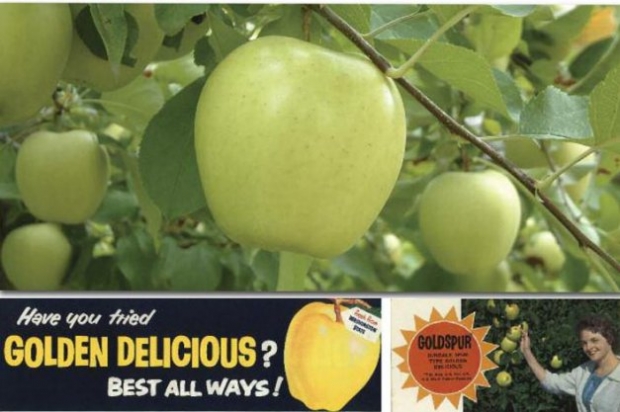
Golden Delicious, the official fruit of West Virginia, originated as a chance seedling on a hillside at Porter’s Creek in Clay County, West Virginia, but there are two versions of how the apple was discovered.
According to widely published accounts, in the fall of 1905, Anderson Mullins noticed a precocious seedling with large yellow apples unlike any he had seen before growing on his property. As he continued to observe the tree over the next few years, it produced an abundant crop annually, even when other trees on the farm were barren. The fruit kept in good condition in the family’s cellar until April.
Mullins named his discovery Mullins Yellow Seedling and in the spring of 1914 sent three apples by parcel post to Stark Brothers Nursery in Missouri. Impressed by its keeping quality and flavor, Paul Stark went to West Virginia to see the tree. The company paid $5,000 for the tree and a 90-square-foot tract on the hillside on which it stood, and for the following 30 years sent the Mullins family $100 a year to maintain the tree. To protect it, the nursery built a lockable steel cage around it with a burglar alarm. Stark Brothers, which already was selling the (red) Delicious apple, renamed the apple Golden Delicious and introduced it in 1916.
Another Mullins
But, according to a 1962 newspaper article in the West Virginia Archives and History, another member of the Mullins family claimed to have discovered the apple earlier. J.M. Mullins said he was born on the farm that his father L.L. Mullins owned and later sold to Anderson. When J.M. was about 15 years old, which would have been 1891, his father sent him out with a scythe to mow the pasture. He was swinging away with the scythe when he came across a little apple tree. Each time he mowed, he avoided the tree until it grew large and bore apples. How did it get there? There was a row of four or five scrawny apple trees by the house that bore yellow apples similar to Grimes Golden, only smaller, he related, and the family figured it grew from a seed from one of those. Later research indicated it could be a cross of Golden Reinette and Grimes Golden.
J.M.’s father gave the piece of the farm with the Golden tree to his son B.W. Mullins and later traded the farm place to his brother Anderson, the one who sent the apples to Stark Brothers. J.M. claimed that Stark Brothers paid $50 for all the fruit from the tree,
not $5,000.
The variety met with immediate acclaim and became a leading cultivar for both fresh and processing purposes in America and abroad. It has several attributes that made it popular. The tree is easy to manage and adaptable to a wide range of soils and climates, and it produces high early yields. Those attributes have made it popular material for breeding programs. Mutsu, Jonagold, Gala, Tentation, and Cripps Pink all have Golden Delicious as a parent.
Its primary weakness is that the skin tends to russet in humid climates. Research has shown that the Smoothee strain has the least russet. Smoothee, a whole tree mutation, was discovered by Carl Gibson in Evans City, Pennsylvania, in 1958, the same year that the original tree on the Mullins property died. It was introduced by Wally Heuser at Hilltop Nursery in 1967 and is the most widely planted strain of Golden Delicious. The patent expired many years ago, but the Smoothee trademark is still held by Hilltop. Some nurseries sell it as “Improved Golden Delicious” or “Gibson Golden Delicious.”
Eclipsed by Gala
Golden Delicious was for many years Washington State’s number-two apple, after Red Delicious. In the 1970s, Red and Golden Delicious apples made up 95 percent of the Washington crop. Golden Delicious production peaked in 1996 at 18 million boxes, but the variety was eclipsed by Gala in 2003. Nationwide, Gala surpassed Golden Delicious in 2008. In Europe, Golden Delicious is still the top variety by far.
The 2010 Washington apple crop estimate indicates 11 million boxes of Golden Delicious, making it the fifth largest variety after Red Delicious, Gala, Fuji, and Granny Smith.
Some information for this article was obtained from A History of Fruit Varieties, which is available from Good Fruit Grower.

Very interesting indeed, Just bought a 2 year old Golden Spur (Goldspur) Cordon having never heard of it before as a newcomer to apple cordons I thought I would try it and see how it grows here in the UK. I will let you know. 😉 P.S. I live in the West Country UK, there is a place called Dunkerton, known area for Farmhouse Cider apple country there is a very old one called Dunkerton Dangler, any information please